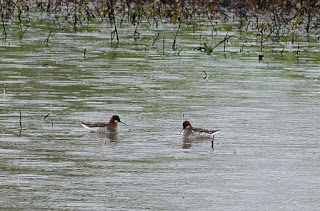The sun may shine bright on my old Kentucky Home, but not today. Even though it's Derby Day here in Louisville, the rain will probably be falling most of the day. What does the fashionable birder wear on such a day? A green rain poncho, of course! Unfortunately, cloudy skies and rain are not the best conditions for photographing a rare bird sighting of these Red Necked Phalarope found on a small pond in a city park nearby, so please forgive the fuzziness of these photos.
Dick remarked that they looked much larger in the field guide, and it was hard to find them at all in the camera lens since they are only about 7" long, with lobed toes and a straight, fine bill. Red-necked Phalaropes, like Red Phalaropes but unlike other shorebirds, prefer to swim rather than wade, a habit that enables them to spend the winter on the high seas, although on occasion they wade in pools and feed on mudflats with many other shorebirds.
When feeding, a Red-necked Phalarope will often swim in a small, rapid circle, forming a small whirlpool. This behavior is thought to aid feeding by raising food from the bottom of shallow water. The bird will reach into the center of the vortex with its bill, plucking small insects or crustaceans caught up therein. On the open ocean, they are often found where converging currents produce upwellings. During migration, some flocks stop over on the open waters at the mouth of the Bay of Fundy to take advantage of food stirred up by tidal action.
How rare are they? Looking at the map, you can see that they breed along the Artic Circle, and winter far to the south. Almost all of the nonbreeding season is spent in open water. As this species rarely comes into contact with humans, it can be unusually tame. Ours weren't concerned at all when some folks with dogs walked by. Easy to see, mid-May-Jul, in the Arctic; otherwise seen on pelagic boat trips during migration or from coasts during on-shore gales in fall.
The typical avian sex roles are reversed in the three phalarope species. Females are larger and more brightly colored than males. These were pretty bright, so we think they are both females. The females pursue and fight over males, and will defend their mate from other females until the clutch is complete and the male begins incubation. The males perform all incubation and chick-rearing activities, while the females may attempt to find another mate. If a male loses his eggs to predation, he may re-pair with his original mate or a new female to try again. Once it becomes too late in the breeding season to start new nests, females begin their southward migration, leaving the males to incubate the eggs and look after the young.
This sure beats going to the track in the rain and having all your possessions search by security people. Did you know that you are NOT allowed to carry umbrellas to Churchill Downs?




No comments:
Post a Comment